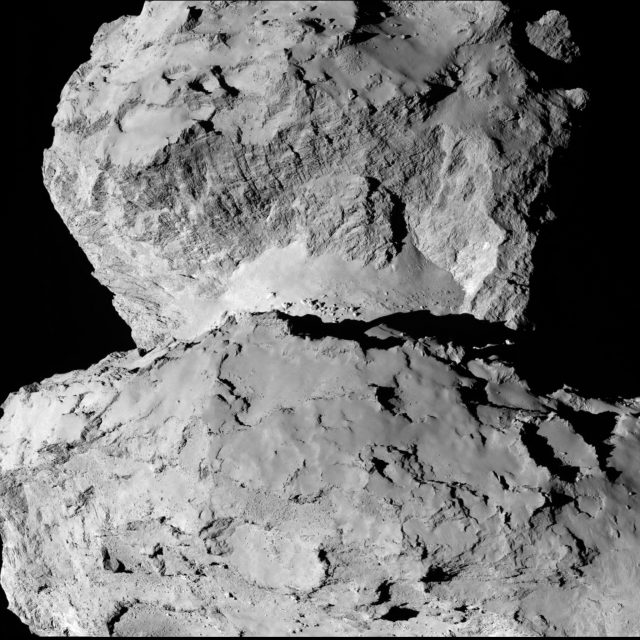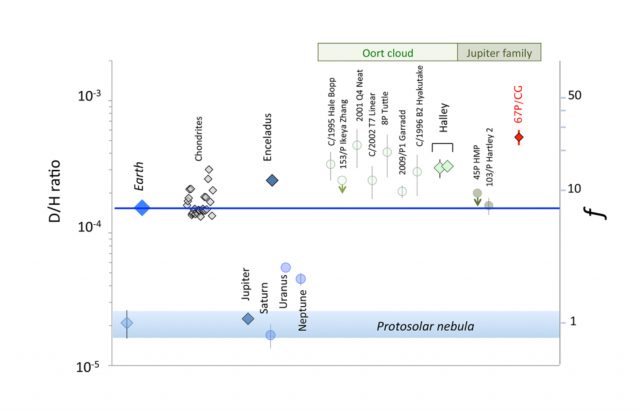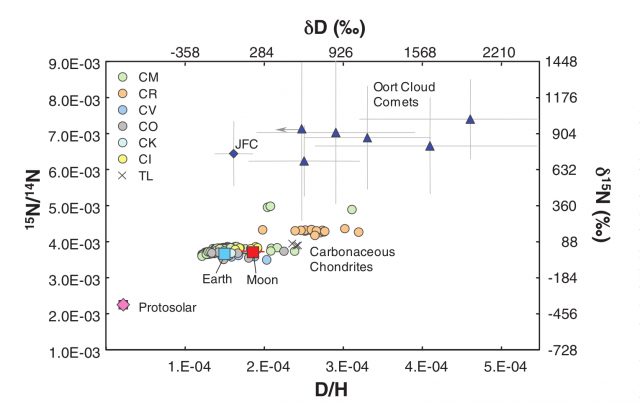A comet for troubled waters

The Rosetta mission from the European Space Agency is arguably one of the most successful highlights of 2014. Even though the Philae lander did not have the placid flight we all would like it to have, the team managed to fulfill most of its scientific goals before the batteries get exhausted and there is still a good chance that sunlight will bring it to life again as the comet gets closer to the Sun. But Philae was just a small part of the mission, and the Rosetta orbiter is still in good health for the months to come. And we expect such month to become more and more exciting as the comet gets fully activated by the rays of the Sun.
But you do not drive so far into the Solar System if you do not have any fundamental question to be answered. Comets and asteroids are often presented as the relics of the ancient Solar System. In some sense, they are like the burials from past cultures which provide information on how the people lived and died many centuries ago. Comets, and asteroids, have in their interiors fundamental information on how our Solar System was when it was formed and are privileged witnesses of the processes that happened during its early evolution. One of this processes is the enrichment of water in a little rocky planet called the Earth. In other words, our fundamental question is: where does the water in our planet come from?
Let’s assume the fact that the Earth was formed too close to the Sun and that it currently contains more water than it should. Therefore, some source of this molecule has to be found. Leaving aside some endogenous processes that could help, there are basically two types of bodies at the other side of the ice line that could have worked as water carriers for the young Earth: asteroids and comets. Recent results based on Rosetta data favor the latter hypothesis 1 as they suggest that the comets have wildly variable amounts of water and thus they cannot be a consistent source for Earth’s water except if, by chance, they contributed to the mean values with the exact proportion of water we can see right now in our oceans. This is good agreement with results found this year using rocks taken by the Apollo 15 and 17 missions 2, which almost perfectly match the kind of water you can find in carbonaceous chondrites asteroids.

Fortunately, we have a good method to distinguish one source of water from another. Water is formed by hydrogen and oxygen, but hydrogen comes in two flavors: the light, normal one and the heavy, less common form called deuterium which has a neutron in the atomic nucleus. Having different atomic masses, they are affected unequally by same processes and lost into space at different rates. This way, the D/H ratio is a signature of where a given kind of water comes from. Following this reasoning, we could identify the source of our water just by measuring the D/H ratio of all candidates to have contributed to the current content of water in our planet.
That being said, it looks like the problem is solved: asteroids contributed substantially to the Earth’s water content and comets did not. End of the problem. However, nothing is that easy in nature. The problem comes when Herschel mission determined that, for the 103P/Hartley 2 comet, the D/H ratio matches quite exactly that of Earth’s oceans 3. This reinforced the old hypothesis of the comets, than can be traced back to the 50s. This theory not only includes the D/H ratio but also the isotopic proportion of many noble gases 4 and other species, such as nitrogen. Noble gases have the tremendous advantage of being much less reactive than other species and thus are not being affected by many chemical processes. This means that you do not only have to match one single parameter, i.e. the D/H ratio, but a bunch of them, i.e. other gases isotopic ratios, if an extraterrestrial source of volatiles had brought a considerable fraction of them in the past.

To make things even most interesting, comets are not all the same. It is commonly accepted that those called the Jupiter Family of Comets (JFC) are different from the more distant Oort Cloud Comets (OCC). OOCs were by no means close enough to Earth’s isotopic ratio to be a reasonable source for our planet’s water. So far, only two OCCs had been analyzed. 103P/Hartley 2, for example, had been observed by Herschel and shown to be remarkably similar to Earth’s oceans. This raised the expectations for the JFCs as one significant source of volatiles. 67P/Churuyumov-Gerasimenko is a JFC too, but the D/H ratio is some three times higher than what it should be to match the model. This makes the new results from Rosetta a very valuable piece of information and, as Altwegg and collaborators point out, suggests that the D/H ratio for JFCs is wildly variable. This puts into question again that comets can be the origin of our water.
We expect much more from Rosetta and we will get it for sure, as the mission goes on and the comets gets closer to the Sun, releasing pristine materials buried deeper into its crust. This will not end our search, in any case, since 67P/C-G is just one of the many JFCs that can be found out there. So we still have to investigate hundreds or thousands of asteroids and comets to be sure about what now seems pretty likely: that carbonaceous asteroids were the main source for our planet’s water. Since we always follow the water in order to look for life, this may open the door for the way we look for habitable worlds outside our Solar System. The amount of water and the way it got to a given planet can be a essential parameter to understand how life can (or cannot) uprise in a distant world.
References
- Altwegg K., A. Bar-Nun, J. J. Berthelier, A. Bieler, P. Bochsler, C. Briois, U. Calmonte, M. Combi, J. De Keyser & P. Eberhardt & (2014). 67P/Churyumov-Gerasimenko, a Jupiter family comet with a high D/H ratio, Science, DOI: http://dx.doi.org/10.1126/science.1261952 ↩
- A.E. Saal et al. (2013). Hydrogen Isotopes in Lunar Volcanic Glasses and Melt Inclusions Reveal a Carbonaceous Chondrite Heritage . Science 340 , 1317 – 1320. doi: 10.1126/science.1235142 ↩
- P. Hartogh et al. (2011). Ocean-like water in the Jupiter-family comet 103P/Hartley 2. Nature 478, 218 – 220. doi: 10.1038/nature10519 ↩
- T. Owen et al. (1992). Possible cometary origin of heavy noble gases in the atmospheres of Venus, Earth and Mars. Nature 358, 43 – 46. doi:10.1038/358043a0 ↩
2 comments
[…] Los cometas, y los asteroides, atesoran en su interior información fundamental sobre como era nuestro sistema solar cuando se formó y son testigos privilegiados de los procesos que tuvieron lugar durante esta evolución temprana. Uno de estos procesos es […]
[…] Kometek eta asteroideek, gure eguzki-sistemaren jaiotzari buruzko oinarrizko informazioa daukate gorderik. Eta horrez gain, eguzki-sistemaren garapen goiztiarrean egon ziren hainbat prozesuen lekuko pribilegiatuak dira. Prozesu horietako bat da, Lurra izena duen planeta harritsu txiki batean gertatutako ur metaketaren prozesua […]